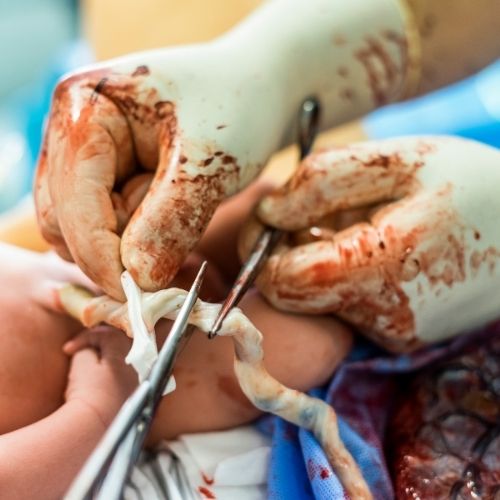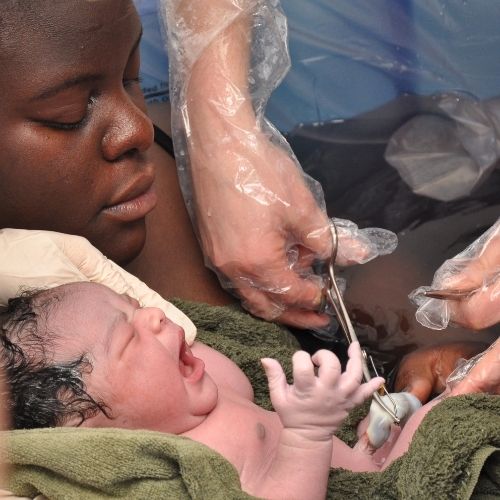Delayed cord clamping has been a hot topic in the birth world over the past few years. If this is your first time hearing about it, it’s when you leave the umbilical cord untouched for some time after the baby is born. But what exactly are the benefits and risks of delaying cord clamping?
First, let’s talk about the cord blood.
During your pregnancy, your body forms an amazing placenta. The placenta acts as the filter between mom and baby: the placenta attaches to the wall of the uterus and is a place where oxygen, nutrients, and waste are exchanged.
Attached to the placenta is the umbilical cord and membranes, also called baby’s sac or the amniotic sac. This is where the baby lives in the amniotic fluid. When we talk about “breaking the water” or “water breaking”, we are referring to the breaking of the membranes.
The umbilical cord attaches the placenta to the baby. It’s what feeds the baby and connects the baby to its placenta. After the baby is born, the placenta is still attached and the cord is still pulsing, meaning there is still blood flow from the placenta to the baby. That oxygen-rich blood can be very beneficial to a newborn.

The benefits of delayed cord clamping
Years ago, once the baby was born and the cord was clamped immediately. After all, once the baby starts breathing, there’s no need for that oxygenated blood from the cord, right?
Not so fast! There are so many benefits to delayed cord clamping and allowing baby to get that last bit of blood from their placenta.
The benefits of delayed cord clamping include improved iron stores and less risk for anemia, improved hemoglobin, better transitional circulation, more red blood cells (and a lesser risk of a baby needing a blood transfusion), and lower incidence of necrotizing entercolitis. All of this information can be found on the ACOG website.
So, when should we cut the cord?
The guidelines on delayed cord clamping are changing and evolving with each new study. Some research says just 30 seconds is effective, but as more research is done we are finding that at least 1 minute, up to 5 minutes, can be beneficial.
One study showed that infants who experienced delaying cord clamping for 5 minutes after birth while the infant was skin to skin with its mother had greater ferritin (iron) levels and increased brain myelin. They compared these infants to those who experienced immediate cord clamping (click here to review the study).
Many providers are choosing to wait until the cord stops pulsing, usually within the first three minutes of birth. After the cord stops pulsing, the transfer of blood between mom and baby is complete. If you are planning on writing a birth plan, this is a good thing to include if it’s important to you.
For help writing your birth plan, click here!

Can you do delayed cord clamping and cord blood banking?
Whether or not you can do both cord blood banking and delayed cord clamping depends on a few different things.
First, some cord blood banks require more blood volume than others. It can also depend on how much blood is in the cord. Some umbilical cords are thick and plump while others are smaller.
If you are choosing private cord blood banking, talk with the coordinator to see if you can do delayed cord clamping as well. Each individual company has a representative with the best info about their collection kits.
The risks of delayed cord clamping
There are few risks that come along with delaying the clamping of the umbilical cord.
First, there is a slight increased risk of neonatal jaundice due to the extra red blood cells that come from the umbilical cord. This is because babies need to break down any extra red blood cells, and a byproduct of that process is bilirubin. Most newborns get frequent bilirubin checks after birth, and neonatal jaundice is easily detected and treated.
If a baby needs resuscitation after birth, doing delayed cord clamping can delay that care of the baby. This is not always true, and some resuscitative measures can be done while the newborn is attached to its mother. In some hospitals and facilities, the newborn resuscitation equipment is not near the mother’s bed and so the cord must be cut for access to that equipment.
It’s always important to talk to your doctor about any questions or concerns you have about your baby’s care. If delayed cord clamping is important to you, bring it up either before or at your child’s birth!
I hope you learned something!
Lindsey, RN-BSN
Founder, BirthSmarts LLC

